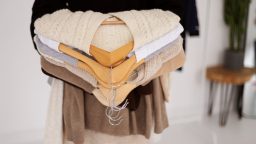When it comes to building a wardrobe that lasts, it’s essential to know how to spot quality clothing. High-quality garments not only look better but they also stand the test of time, making them a smart investment in your personal style. However, with so many options available, it can be challenging to identify which pieces are truly worth the money. Don’t worry – with a little knowledge and a keen eye, you can learn how to recognise quality clothing. Here are some top tips and tricks to help you make informed decisions when shopping for clothes.
- Check the Fabric
The first thing to consider when evaluating the quality of clothing is the fabric. High-quality garments are typically made from natural materials, such as cotton, linen, wool, or silk. These fabrics are breathable, comfortable, and durable. When you touch a piece of clothing, you should be able to feel the difference between high-quality and low-quality fabrics. Natural fibres feel more substantial and smooth, whereas synthetic materials can feel flimsy or rough.
For example, a wool sweater should feel soft and have a bit of natural elasticity. If it feels stiff or too shiny, it’s likely made from a lower-quality synthetic fibre. Similarly, cotton garments should feel soft and substantial, not thin or see-through. If you’re shopping for denim, remember that premium denim feels sturdy and thicker, with a well-crafted finish.
- Inspect the Stitching
A key indicator of quality is the stitching on the garment. High-quality clothing often features neat, even, and tight stitching. Run your fingers along the seams to check for any loose threads or uneven stitching, which can be a sign of poor craftsmanship. The stitching should be consistent and strong, with no visible gaps. If you notice any loose threads, fraying, or missed stitches, it’s best to move on to another item.
A good rule of thumb is to check the inside of the garment. Higher-end pieces typically have well-finished interior seams that are either bound or overlocked to prevent fraying. If the inside looks messy or unfinished, it’s a red flag.
- Pay Attention to Fit
One of the most important factors in spotting quality clothing is the fit. A well-made garment will have a tailored fit that flatters your body shape. This doesn’t necessarily mean the garment should be tight, but it should fit well and hang properly. A high-quality piece will drape naturally over your body without pulling or bunching, and the shoulders, sleeves, and waist should align correctly.
If you find that a piece fits well in one area but poorly in another (for example, the shoulders are too tight but the waist is too loose), it’s probably not made with the same attention to detail as a well-constructed item. Remember, proper fit is a sign that the garment was designed and made with care.
- Look for Quality Fastenings
The small details can make a huge difference when it comes to quality clothing. High-quality garments tend to feature durable, well-made fastenings, such as buttons, zippers, and hooks. Check the buttons to see if they’re securely attached and made from a sturdy material like wood, metal, or high-quality plastic. Cheap clothing often uses flimsy buttons that can break easily or feel lightweight.
Zippers should glide smoothly and be made from durable metals such as brass or stainless steel. Avoid zippers that catch, feel flimsy, or have visible defects. Quality fastenings are not only functional but also add to the overall look and longevity of a garment.
- Examine the Construction and Detailing
When it comes to quality clothing, attention to detail is key. Look at the overall construction of the garment. Are the hems even and properly finished? Are there any visible flaws, such as mismatched patterns, uneven pleats, or crooked lines? Quality clothing tends to have carefully placed details, such as matching patterns, aligned stripes, and evenly spaced pleats or darts.
In addition, check the finishing touches, such as labels and tags. High-end brands often use high-quality fabric tags that are securely attached, while lower-end brands may have flimsy or cheap-looking labels.
- Consider the Brand Reputation
While it’s not always a guarantee of quality, the brand’s reputation can give you a good indication of the garment’s craftsmanship. Established brands known for their commitment to quality often invest in better materials, skilled production, and superior construction. Take some time to research a brand before making a purchase. Check customer reviews and look at how the brand is regarded in the fashion industry. Some brands are renowned for their attention to detail and the durability of their clothing, which can give you confidence in your purchase.
- Assess the Price
While price isn’t always an accurate reflection of quality, it often plays a role. Quality clothing tends to be more expensive due to the superior materials, craftsmanship, and attention to detail involved. However, this doesn’t mean you need to break the bank for quality pieces. Look out for sales, discounts, and outlet stores where you can purchase high-end garments at a more affordable price.
Remember, when buying quality clothing, you’re making an investment. It’s better to spend a little more on a well-made piece that will last for years than to buy cheaper items that wear out quickly.
- Check the Care Instructions
The care instructions on a garment can offer valuable insight into its quality. High-quality clothing often requires a bit more care to maintain its appearance, such as dry cleaning or hand washing. If the care instructions are minimal (e.g., machine wash on low heat), the garment may be made from lower-quality materials that can withstand more aggressive washing.
However, be aware that some premium fabrics, such as wool or silk, may require extra care to maintain their look and feel. So, make sure you’re willing to put in the effort to care for the garment before committing to a purchase.
Conclusion
Spotting quality clothing doesn’t have to be difficult once you know what to look for. By paying attention to the fabric, stitching, fit, fastenings, construction, and other details, you can easily distinguish between well-made garments and low-quality alternatives. With these tips in mind, you’ll be able to build a wardrobe filled with clothing that lasts, looks great, and provides long-term value. So, the next time you’re shopping, trust your instincts and take the time to evaluate each piece carefully – quality always stands out.





